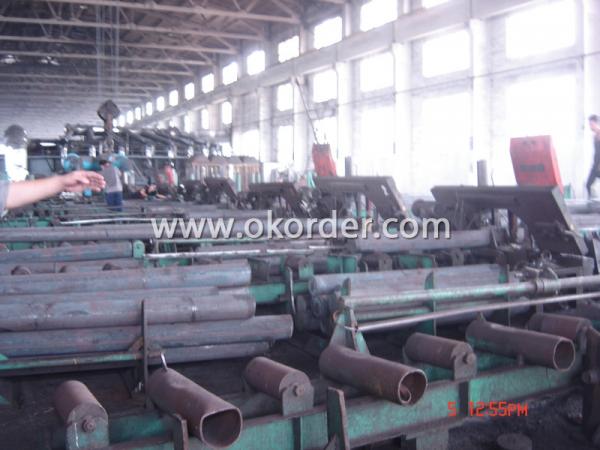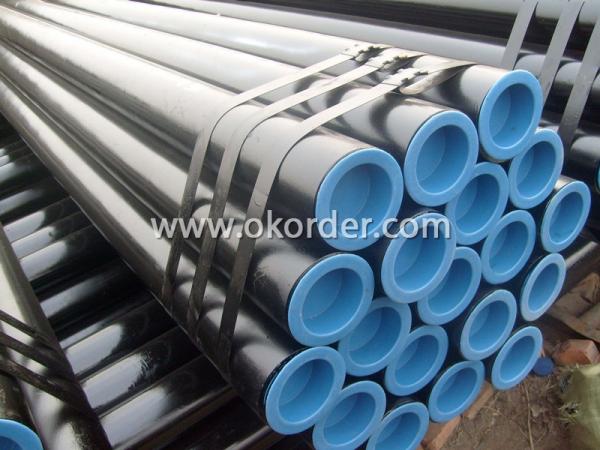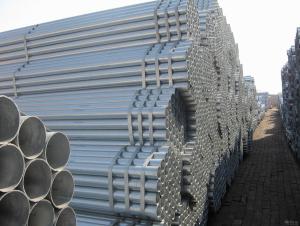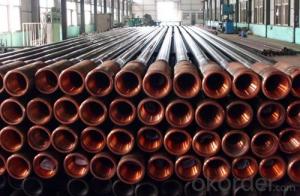High Quality API 5DP NS-1 Oilfield Drill Pipe
- Loading Port:
- China Main Port
- Payment Terms:
- TT or LC
- Min Order Qty:
- Negotiable m.t.
- Supply Capability:
- 5000 Tons Per Month m.t./month
OKorder Service Pledge
OKorder Financial Service
You Might Also Like
|
|
|
|
|
|
|
|
|
|
|
|
|
|
|
|
|
| Designations |
| Pipe body |
| Calculated weight |
|
|
| Upset dimensions |
|
|
|
| |||
|
|
|
|
|
|
|
| OD |
| Length of | Length of | Length of | Length of | Length end of |
| |
|
|
|
|
|
|
|
|
| ID at End |
| ||||||
| Size | Nominal | OD | WT | ID | Plain end | Upset |
| internal | internal | external | external | pipe to taper |
| ||
|
| of Pipe | upset | taper | upset | taper | fade out |
| ||||||||
|
| weight |
|
|
|
|
|
|
|
| ||||||
|
|
|
|
|
|
| +1/8 | ±1/16 | +1 1/2 | Min. | Min. | Min. | Min. | Max. |
| |
|
|
|
|
|
|
|
|
| ||||||||
|
|
|
|
|
|
|
| -1/32 | - 1/2 |
| ||||||
|
|
|
|
|
|
|
|
|
|
|
|
|
|
| ||
| in | lb/ft | in | in | in | lb/ft | lb/ft | in | in | in | in | in | in | in | in |
|
|
|
|
|
|
|
|
|
|
|
|
|
|
|
| ||
D | t | d | wpe | ew | Dou | dou | Liu | miu | Leu | meu | meu | Leu+meu |
| |||
|
|
|
| |||||||||||||
|
|
|
|
|
|
|
| Internalupset |
|
|
|
|
|
|
| |
|
|
|
|
|
|
|
|
|
|
|
|
|
|
|
| |
2 7/8 | 10.40 | 2.875 | 0.362 | 2.151 | 9.72 | 3.20 | 2.875 | 1 15/16 | 1 3/4 | 1 1/2 | - | - | - | - |
| |
|
|
|
|
|
|
|
|
|
|
|
|
|
|
|
|
|
|
| 9.50 | 3.500 | 0.254 | 2.992 | 8.81 | 4.40 | 3.500 | 2 1/4 | 1 3/4 | - | - | - | - | - |
|
3 1/2 |
|
|
|
|
|
|
|
|
|
|
|
|
|
|
| |
13.30 | 3.500 | 0.368 | 2.764 | 12.31 | 4.40 | 3.500 | 1 15/16 | 1 3/4 | 1 1/2 | - | - | - | - |
| ||
|
|
|
|
|
|
|
|
|
|
|
|
|
|
|
|
|
|
| 15.50 | 3.500 | 0.449 | 2.602 | 14.63 | 3.40 | 3.500 | 1 15/16 | 1 3/4 | 1 1/2 | - | - | - | - |
|
|
|
|
|
|
|
|
|
|
|
|
|
|
|
|
|
|
4 | 11.85 | 4.000 | 0.262 | 3.476 | 10.46 | 4.20 | 4.000 | 2 15/16 | 1 3/4 | - | - | - | - | - |
| |
|
|
|
|
|
|
|
|
|
|
|
|
|
|
| ||
14.00 | 4.000 | 0.330 | 3.340 | 12.93 | 4.60 | 4.250 | 2 3/4 | 1 3/4 | 2 | - | - | - | - |
| ||
|
|
| ||||||||||||||
|
|
|
|
|
|
|
|
|
|
|
|
|
|
|
| |
4 1/2 | 13.75 | 4.500 | 0.271 | 3.958 | 12.24 | 5.20 | 4.750 | 3 3/8 | 1 3/4 | - | - | - | - | - |
| |
|
|
|
|
|
|
|
|
|
|
|
|
|
|
|
| |
5 | 16.25 | 5.000 | 0.296 | 4.408 | 14.87 | 6.60 | 5.000 | 3 3/4 | 1 3/4 | - | - | - | - | - |
| |
|
|
|
|
|
|
|
|
|
|
|
|
|
|
|
|
|
|
|
|
|
|
|
|
| Externalupset |
|
|
|
|
|
|
| |
|
|
|
|
|
|
|
|
|
|
|
|
|
|
|
| |
2 3/8 | 6.65 | 2.375 | 0.280 | 1.815 | 6.26 | 1.80 | 2.656 | 1.815 | - | - | 1 1/2 | 1 1/2 | - | 4 |
| |
|
|
|
|
|
|
|
|
|
|
|
|
|
|
|
| |
2 7/8 | 10.40 | 2.875 | 0.362 | 2.151 | 9.72 | 2.40 | 3.219 | 2.151 | - | - | 1 1/2 | 1 1/2 | - | 4 |
| |
|
|
|
|
|
|
|
|
|
|
|
|
|
|
|
|
|
|
| 9.50 | 3.500 | 0.254 | 2.992 | 8.81 | 2.60 | 3.938 | 2.992 | - | - | 1 1/2 | 1 1/2 | - | 4 |
|
3 1/2 |
|
|
|
|
|
|
|
|
|
|
|
|
|
|
| |
13.30 | 3.500 | 0.368 | 2.764 | 12.31 | 4.00 | 3.938 | 2.602 | 2 1/4 | 2 | 1 1/2 | 1 1/2 | - | 4 |
| ||
|
|
|
|
|
|
|
|
|
|
|
|
|
|
|
|
|
|
| 15.50 | 3.500 | 0.449 | 2.602 | 14.63 | 2.80 | 3.938 | 2.602 | - | - | 1 1/2 | 1 1/2 | - | 4 |
|
|
|
|
|
|
|
|
|
|
|
|
|
|
|
|
|
|
4 | 11.85 | 4.000 | 0.262 | 3.476 | 10.46 | 5.00 | 4.500 | 3.476 | - | - | 1 1/2 | 1 1/2 | - | 4 |
| |
|
|
|
|
|
|
|
|
|
|
|
|
|
|
| ||
14.00 | 4.000 | 0.330 | 3.340 | 12.93 | 5.00 | 4.563 | 3.340 | - | - | 1 1/2 | 1 1/2 | - | 4 |
| ||
|
|
| ||||||||||||||
|
|
|
|
|
|
|
|
|
|
|
|
|
|
|
|
|
|
| 13.75 | 4.500 | 0.271 | 3.958 | 12.24 | 5.60 | 5.063 | 3.958 | - | - | 1 1/2 | 1 1/2 | - | 4 |
|
4 1/2 |
|
|
|
|
|
|
|
|
|
|
|
|
|
|
| |
16.60 | 4.500 | 0.337 | 3.826 | 14.98 | 5.60 | 5.063 | 3.826 | - | - | 1 1/2 | 1 1/2 | - | 4 |
| ||
|
|
|
|
|
|
|
|
|
|
|
|
|
|
|
|
|
|
| 20.00 | 4.500 | 0.430 | 3.640 | 18.69 | 5.60 | 5.063 | 3.640 | - | - | 1 1/2 | 1 1/2 | - | 4 |
|
|
|
|
|
|
|
|
|
|
|
|
|
|
|
|
|
|
The manufacturing shop of steel pipe




The package of steel pipe


- Q: How are steel pipes recycled at the end of their life cycle?
- Steel pipes are typically recycled at the end of their life cycle through a process called steel recycling. This involves collecting the used pipes, separating them from other materials, and then melting them down to be formed into new steel products. The recycling process not only helps conserve valuable resources but also reduces the need for new steel production, making it an environmentally sustainable solution.
- Q: Can steel pipes be used for heating and cooling systems?
- Yes, steel pipes can be used for heating and cooling systems. Steel pipes are commonly used in HVAC (heating, ventilation, and air conditioning) systems as they have excellent heat transfer properties, durability, and can withstand high-pressure conditions. Additionally, steel pipes are resistant to corrosion, making them suitable for both heating and cooling applications.
- Q: What does cathodic protection of steel tubes mean?
- Applied current: a macro cell consisting of a protected metal piece and an insoluble auxiliary component. The negative electrode of the battery is connected to the metal to be protected. The power supplies the electrons so that the metal is not corroded by missing points.
- Q: How do you calculate the pipe pressure drop coefficient for steel pipes?
- To calculate the pipe pressure drop coefficient for steel pipes, you can use the Darcy-Weisbach equation, which takes into account factors such as the pipe length, diameter, roughness, and fluid flow rate. The coefficient can be determined using empirical correlations or charts based on these parameters, ensuring accurate estimation of pressure drop in steel pipes.
- Q: How are steel pipes used in the construction of nuclear power plants?
- Steel pipes are widely used in the construction of nuclear power plants for various critical applications. They are employed in the primary coolant system, where they carry and circulate the pressurized water or liquid metal coolant that transfers heat from the reactor core to the steam generator. Steel pipes are also utilized in the secondary coolant system, which transports the generated steam to drive the turbine for electricity production. Additionally, steel pipes are used for the construction of various auxiliary systems, such as the emergency cooling system or the ventilation system, ensuring the safe and efficient operation of nuclear power plants.
- Q: What are the different types of coatings used for external protection of steel pipes?
- There are several types of coatings commonly used for the external protection of steel pipes, including fusion bonded epoxy (FBE) coatings, three-layer polyethylene (3LPE) coatings, three-layer polypropylene (3LPP) coatings, and coal tar enamel (CTE) coatings. Each of these coatings provide different levels of corrosion resistance and durability, depending on the specific requirements of the project or application.
- Q: Can steel pipes be used for conveying solid materials?
- Yes, steel pipes can be used for conveying solid materials. Steel pipes are known for their high strength and durability, making them suitable for transporting solid materials such as ores, grains, or construction materials. They are commonly used in industries such as mining, agriculture, and construction for this purpose.
- Q: How are steel pipes used in plumbing systems?
- Steel pipes are commonly used in plumbing systems for their durability and strength. They are used to transport water, gas, and waste materials in both residential and commercial buildings. Steel pipes are known for their resistance to corrosion and high pressure, making them ideal for underground and outdoor applications. Additionally, steel pipes are often used for plumbing fixtures such as faucets, showers, and toilets, providing a reliable and long-lasting solution for water distribution and drainage.
- Q: What are the different methods of protecting steel pipes from corrosion?
- There are several methods of protecting steel pipes from corrosion. One common method is coating the pipes with materials such as epoxy, polyethylene, or fusion bonded epoxy, which create a barrier between the pipe's surface and corrosive elements. Another method is cathodic protection, which involves using sacrificial anodes or impressed current to prevent corrosion. Additionally, applying corrosion inhibitors or using corrosion-resistant alloys for manufacturing the pipes can provide protection. Regular maintenance, including inspections and cleaning, is also crucial to ensure the ongoing protection of steel pipes from corrosion.
- Q: Can steel pipes be used for fencing?
- Yes, steel pipes can be used for fencing. They are a popular choice for fencing due to their strength, durability, and ability to withstand harsh weather conditions. Steel pipes provide a sturdy and secure barrier, making them suitable for various fencing applications such as residential, commercial, and industrial settings.
1. Manufacturer Overview
| Location | Wuxi, China |
| Year Established | 1991 |
| Annual Output Value | 300,000Tons |
| Main Markets | Europe; Southeast Asia; etc. |
| Company Certifications | API 5L;API 5CT;API Q1;ISO/TS29001 |
2. Manufacturer Certificates
| a) Certification Name | |
| Range | |
| Reference | |
| Validity Period |
3. Manufacturer Capability
| a) Trade Capacity | |
| Nearest Port | Wuxi; Shanghai |
| Export Percentage | 41% - 50% |
| No.of Employees in Trade Department | 3900-4000 People |
| Language Spoken: | English; Chinese; Spanish |
| b) Factory Information | |
| Factory Size: | Above 450,000 square meters |
| No. of Production Lines | Above 10 |
| Contract Manufacturing | OEM Service Offered;Design Service Offered |
| Product Price Range | Average |
Send your message to us
High Quality API 5DP NS-1 Oilfield Drill Pipe
- Loading Port:
- China Main Port
- Payment Terms:
- TT or LC
- Min Order Qty:
- Negotiable m.t.
- Supply Capability:
- 5000 Tons Per Month m.t./month
OKorder Service Pledge
OKorder Financial Service
Similar products
Hot products
Hot Searches
Related keywords




























